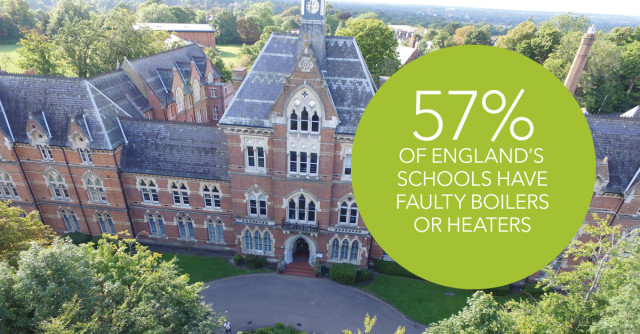Setting schools on the path to net zero

UK schools are ageing, and their heating systems have seen better days. Taking immediate action to refurbish them is vital to put these ‘hard-to-tackle’ educational buildings on the road to the future of heating.
The UK government recently announced that it will introduce a more ambitious target to reduce emissions by 78% by 2035, compared to 1990 levels, as part of a new Sixth Carbon Budget. As this will require the near total decarbonisation of heat in buildings, the building services industry has a critical role to play in achieving this goal.
Setting the UK’s ‘hard-to-tackle’ existing building stock on the road to net zero is a tough but urgent challenge. The need for action is particularly pressing in the education sector which has a high proportion of ageing buildings – many with heating systems that have seen better days.
Recognising this, the government has introduced a ten-year rebuilding programme and included schools within the Public Sector Decarbonisation Scheme to install energy efficiency and low carbon heating measures.
Heating manufacturers are supporting the move to the future of heat with innovative technologies and techniques, including hydrogen boilers, heat pumps and equipment to support the delivery of heat networks.
However, schools embarking on a heating refurbishment programme often face a range of obstacles that make use of some alternative technologies very difficult.
So, how can manufacturers and building services professionals help schools to bring these hard-to-treat buildings – and their heating systems – up to code?
Design challenges
First let’s consider the design issues on schools heating refurbishment projects. Some schools may be dealing with the cast iron radiators and poorly-fitting windows of a Victorian primary school. Others will be contending with poor insulation or overheating from large glazed areas in the more modern, but equally problematic, secondary school buildings of the 1960s and 1970s.
In both building types, tight budgets unfortunately mean that maintenance of heating systems can be neglected for extended periods – even until failure. Indeed, some 57% of England’s schools have faulty boilers or heaters, according to the Times Educational Supplement (TES). This can then cause problems with hydronics and uneven heating output, resulting in classrooms that are either too hot or too cold.
Phased approach
For many schools, switching from dated non-condensing boilers to low carbon technologies in one leap simply won’t be a technically or economically viable option at present. But if we are to achieve our climate goals, it’s vital to seize every opportunity to improve heating and hot water efficiencies in our existing schools.
A practical solution is to adopt a phased approach that will enable schools to plan and budget adequately to meet their long-term needs.
In poorly insulated buildings, energy efficiency measures should be the first step to reduce heat losses and lower heat demand.
Addressing the system’s distribution pipework and heat emitters to operate at lower temperatures than the traditional 82°C/71°C system designs is the next stage. This will future proof the building and the heating system for the integration of lower temperature, low carbon technologies.
And in the immediate term, replacing any old heating plant with modern energy-efficient gas boilers offers a cost-effective and timely means of achieving emissions reduction from this part of the public building stock. Taking steps like this now will save emissions sooner – and provide a ready solution for schools that face inadequate heating and hot water provision.
Holistic system thinking

Given the age of the buildings, careful planning is central to success. The boiler is the heart of the system, generating the heat, and as such can have the most impact on energy and emission savings. But finding a convenient time to carry out even a relatively straightforward boiler replacement can be challenging, given that work is typically carried out during the fixed periods of school shutdown.
Budget is a significant factor for schools, so it’s critical to identify the solutions that offer the most beneficial impact within budget while meeting their short- and long-term outcomes.
The heating system includes a range of equipment, including the pipework and radiators on the distribution side. It’s therefore essential to take a holistic look at system design to achieve the best possible solution to meet all project and site requirements and meet the school’s immediate and long-term needs. This may dictate whether the project involves a boiler replacement using existing pipework, or a more involved project that removes existing pipework before replacement.
A further consideration is water quality, as this has a considerable impact on the performance of heating and hot water systems. While it is sometimes possible to re-use older pipework in a refurbishment project, this should be considered in light of factors such as the age and condition of the existing system.
Modern heating technologies and techniques
Keeping up to date with the latest heating technologies and techniques will make it easier to meet modern heat challenges and demands. Early consultation with manufacturers will help ensure that the most appropriate solution is selected for the project that achieves the required outcomes within budget.
Remeha’s time-saving, offsite-fabricated heating systems, for example; might provide the best solution for a school that needs a school boiler replacement to take place in a half-term break rather than during the summer holidays. Or for schools keen to future proof the system to integrate low carbon technology at a later date, selecting a next-generation boiler like the Gas 320/620 Ace with a wide temperature differential and operating range, might best meet the requirement.
Controls
Ensuring that an adequate control strategy is in place is crucial to optimise performance and efficiency. While this doesn’t have to be elaborate, it is advisable to consider new approaches to controls to reflect the performance of modern heating technology. This might include updating the sequencing of boilers to suit the new equipment and any changes to heating and hot water demands created by usage patterns.
Early engagement
Refurbishing school heating systems might ultimately mean a shift to heat pumps, smart electric water heating equipment, or hydrogen boilers. But where the feasible options are currently limited, it’s imperative to act on the achievable opportunities for energy and emissions reduction.
With early engagement between consultant engineers, specifiers, contractors and manufacturers, we can identify the appropriate stages and overcome the typical refurbishment challenges. Whatever is deemed the appropriate technology of the future for the individual school building, progress will be much easier to achieve if we, as an industry, work together to lay firm foundations now.
Andy Green is Technical Director at Baxi Heating.







